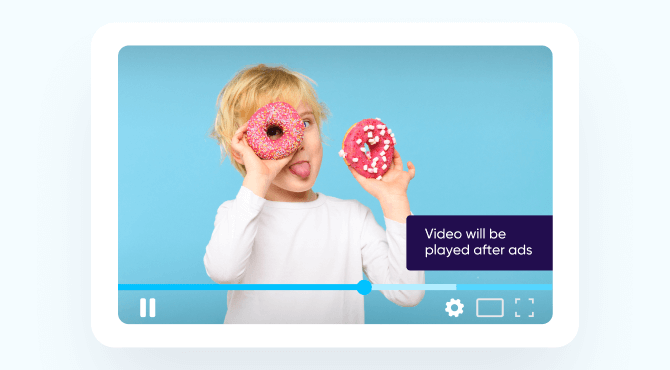
Let’s get rolling: The ultimate guide to pre-roll ads

The average person watches 17 hours of online video a week — a 62% increase from 2018. If you want to reach new customers, video marketing is a must-add to your marketing mix.
Most marketers choose an in-stream video ad placement, which means your ad appears inside the video stream. In-stream video ads come in three types: pre-roll (before the video), mid-roll (during the video), and post-roll (after the video). If you’re curious about pre-roll ads, you’ve come to the right place — read on to learn how they work, their benefits, and best practices for advertisers.
What are pre-roll ads?
Pre-roll ads are an in-stream video ad format that plays before a viewer’s chosen video content.

Which platforms use pre-roll ads?
Popular video platforms including YouTube, Facebook, and Instagram offer pre-roll ads to advertisers. Other platforms that use them include OTT publishers (like Netflix or Hulu), mobile games, and audio publishers like Spotify.
Types of pre-roll ads
Within pre-roll ads, there are several different types. Understanding their strengths and pairing them with your marketing goals will help you run the best campaign for your brand.
Skippable pre-roll ads
Skippable ads are ads that viewers can skip either immediately or after a certain duration, like five seconds. Most people have encountered this type of ad when watching YouTube.
Non-skippable pre-roll ads
When you can’t skip an ad before starting your content, it’s called a non-skippable pre-roll ad. Non-skippable ads are common when streaming shows or completing an action to access free content.
Bumper pre-roll ads
Bumper pre-roll ads are short-form pre-roll ads that can’t be skipped. These mini video ads last six seconds or less, and are a quick, non-interruptive opportunity for brand exposure.

What are the benefits of pre-roll ads?
Viewers encounter pre-roll ads early on in a viewing experience when they’re focused and ready to engage. While they aren’t the best place for conversions — viewers are eager to move on to their content — pre-roll ads are still a valuable investment. Here’s why:
1. Captive audience with higher engagement
Imagine this scenario: you settle yourself on the couch with your favorite snack and select the new episode of your favorite show. An ad plays before your content starts, but you don’t mind. You’re a captive audience. A study by YuMe found that viewers find pre-roll ads more informative and engaging than other ad placements.

2. Less interruptive
The same study discovered that viewers consider pre-roll ads 3.5 times less interruptive than other placements. This is partly because they’re not yet engrossed in their content, but there’s more to it. Viewers are more likely to see pre-roll ads as a type of value exchange for free content.
3. Highest brand recall
If conversions aren’t your top goal with pre-roll ads, then you need to look at brand recall. Since they’re paying attention, consumers are much more likely to remember the brand and messaging in pre-roll ads. A YuMe test found that viewers have a 69% aided brand recall rate on desktop and a 72% aided recall rate on mobile.
Pre-roll ads best practices
Not sure how to create the best pre-roll experience for viewers? These tips will help you maximize your five seconds of fame (for skippable ads) for a memorable brand interaction.
Reveal your brand early and often
Since brand recall is pre-roll ads’ greatest strength, you can optimize your viewers’ attention spans by placing your brand name early and often. Research by Facebook found that videos that reveal the brand in the first three seconds have 1.23 times higher aided recall than traditional narrative ads. It’s best to include the brand name at the end of your ad as well for the greatest impact.
Design for a mobile-first experience
According to Facebook data, in-stream ads designed for mobile first perform the best for brand recall. Mobile-first ads are short (average of 20 seconds), designed to be viewed with sound off (using subtitles or visual storytelling), and reveal the brand in the first three seconds. You should also consider the format of the ad you’re creating, since many mobile-first ads are in portrait orientation.
Enable autoplay
Enabling autoplay means that your video ad will play whether the viewer clicks on the video content or not – they simply have to visit the page it’s on. This gives your video a higher chance of being viewed and drawing a user’s attention. Keep in mind, though, that most platforms mute autoplay ad content, so optimize for sound-off viewing.

Make them skippable
Since we’ve touted pre-roll ads as playing to a captive audience, it may seem counterintuitive to make your ads skippable. However, giving your viewers a choice in how they interact with your brand is always a smart move.
Both Facebook and YouTube have an option for viewers to skip pre-roll ads after five seconds. Non-skippable ads are limited to 15 seconds on both platforms, but skippable ads can be 30 seconds or more. On YouTube, you have extra interactive features to sweeten the deal, like call-to-action buttons, links, and product feeds.
Researchers from Duke University found that viewers are likely to watch the entire video if they anticipate helpful information – and then are more likely to convert. This optimizes your ad spend, as you can choose to only pay for viewers who complete the video and are most likely to buy from you.
Consider the context and audience
Most of the time, you don’t know the exact content your ad will play alongside, since ad placements are automated and determined by algorithm. However, you can practice contextual advertising by considering the platform and audience you’re targeting.
Is your target audience combing YouTube for weeknight recipes? Or are they listening to a podcast where they might also be out jogging or in a car? Hulu recommends making “a clever nod to the streaming viewer and their environment and preferences” in your content.
How to implement a pre-roll ad campaign
Now that you have the theory, you’re ready to get started. Here are the six steps you need to complete to launch your first pre-roll ad campaign.
1. Create a campaign strategy
If you don’t already have it, create a marketing campaign strategy outlining your goals, budget, key messaging, and target audience personas. What do you want to accomplish with this campaign?
2. Choose the right platforms for your campaign
Use market research to determine which platform is the best to reach your needs. If you work with an agency, ask them to make recommendations and multiple placements for you. However, you can also place ads on most platforms yourself.
3. Create your video
With the technical specifications and context for those platforms, create your video content. Focus on what makes your brand different and don’t be afraid to use your unique voice. Place your brand front and center, use strong visuals, and include links and calls to action.
4. Set parameters
At this stage, define your budget and target audience in more detail. Select which channels your ad will play on (or not play on, if you want to suppress certain categories). If you plan to use ad podding, where you can place pre-roll, mid-roll, or post-roll ads together, complete this process now.

5. Place a bid
Use an ad manager account to place bids for your preferred metrics and budget. Strategies like real-time ad bidding let you automate your bids and optimize your performance and budget.
6. Post your video
Upload your pre-roll video and hit publish – your campaign is live! Keep a close eye on results for the first few days to see if you need to make any adjustments.
Key takeaways
- Pre-roll ads are shown before a user watches their chosen content. They’re common on platforms like YouTube, Facebook, and Instagram.
- The benefits of pre-roll ads include higher engagement, less interruption for the viewer, and higher brand recall.
- Skippable ads can be longer and have more interactive features than non-skippable ones. They also make for a better user experience. Alternatively, you can use short, non-skippable “bumper” ads to highlight your brand.
- To maximize brand recall, design your video ad for mobile first: it should be short (20 seconds max), work with sound off, and reveal your brand in the first three seconds. Remember to also consider your audience context and enable autoplay for maximum views.
- Your pre-roll ads should be aligned to your strategy and meet your chosen platform’s technical specifications. Once you’ve secured a bid that fits your budget, you can publish your ad and monitor the results.




